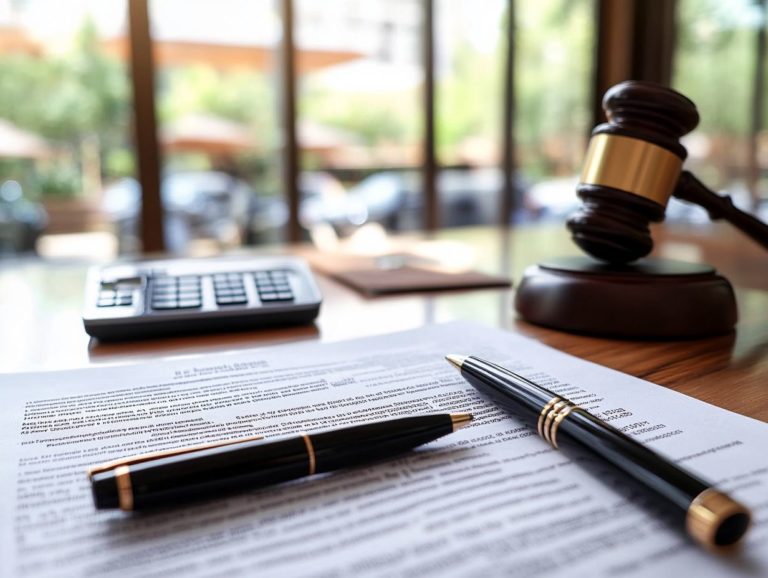Understanding the Patent Application Process Timeline
Navigating the patent application process can feel overwhelming. However, understanding its essentials is crucial for you as an inventor or innovator.
This article distills the key components. It begins with the definition of a patent and the steps necessary to secure one. You ll discover how to prepare effectively, understand the critical role of a patent attorney, and navigate the complexities of filing your application.
We ll also outline the timeline you can anticipate and what unfolds after you submit your application. Whether you re a seasoned inventor or just starting your journey, this guide equips you with the knowledge to safeguard your ideas.
Contents
- Key Takeaways:
- Overview of the Patent Application Process
- Preparing for the Patent Application
- Filing the Patent Application
- Types of Patent Applications
- Filling Out the Application Form
- Timeline of the Patent Application Process
- After Filing the Patent Application
- Frequently Asked Questions
- What is the patent application process timeline?
- How long does the patent application process typically take?
- What are the different stages of the patent application process timeline?
- What happens during the examination stage of the patent application process timeline?
- What is the publication stage of the patent application process timeline?
- What are my options if my patent application is rejected?
Key Takeaways:

The patent application process can be complex, but it is important to understand the steps involved to successfully protect your invention. Working with a patent attorney can greatly assist in navigating the process and ensuring all necessary documentation and research are completed before filing. The timeline for the patent application process can vary but generally includes steps such as filing, examination, and potential responses from the patent office.
Overview of the Patent Application Process
The patent application process is an essential avenue for you as an inventor to safeguard the rights to your ideas. It enables you to protect your groundbreaking concepts from unauthorized use.
This exciting journey has key stages you must tackle without delay, including initial research, filing, examination, and the final grant. These stages are all governed by patent law and the regulations established by the United States Patent and Trademark Office (USPTO).
Grasping the nuances of this process is crucial for independent inventors and enterprises alike. It ensures that your inventions meet the necessary patent requirements and are effectively defended in the marketplace.
What is a Patent?
A patent serves as a powerful legal instrument that grants you exclusive rights to your inventions. This means you can prevent others from making, using, or selling your invention without your permission. Patents foster an environment where innovation and creativity can thrive, ensuring you benefit from your hard work.
Understanding the various types of patents is essential for anyone looking to protect their inventions. Utility patents cover new and useful processes, machines, or compositions of matter and are the most prevalent. Design patents safeguard the ornamental aspects of an invention, while plant patents are specifically for new varieties of plants that have been asexually reproduced.
The criteria for patentability typically consist of novelty, non-obviousness, and utility. This highlights the crucial role of originality in patent applications. Protecting the rights to your ideas is vital not only for individual creators but also for the advancement of technology and culture as a whole.
Steps in the Patent Application Process
The steps you need to take in the patent application process can be intricate. It all begins with an initial prior art search to determine the novelty of your proposed invention.
Next, you’ll draft and file your patent application, complete with the required patent claims that establish the scope of protection you seek. Each of these steps is crucial to ensure that your application meets the patent requirements set forth by the USPTO.
Enlisting the help of a patent attorney is invaluable for navigating the complexities of patent prosecution.
To streamline this process, first, conduct thorough market research and gather all necessary documentation, including technical descriptions and drawings of your invention.
Once your application is drafted, it s time to file it with the relevant authorities. This will trigger an examination phase where patent examiners assess compliance with regulations. Engaging a skilled patent attorney can significantly enhance your chances of success.
They provide essential insights into filing strategies that align with legal nuances. This partnership allows you to focus on your innovation while ensuring your intellectual property is well-protected throughout the application journey.
Preparing for the Patent Application
Preparing for a patent application demands careful research. Start with an invention disclosure that clearly describes the details of your patentable invention.
Ensure that every aspect is thoroughly documented before considering the patent filing stage. This journey often involves working with patent attorneys, who can guide you through the laws that protect inventions and creative works.
They’ll help craft a strong application that highlights your invention’s uniqueness and inventive step, setting you up for success in the competitive landscape of innovation.
Preliminary Research and Documentation

Conducting thorough preliminary research and documentation is essential in your patent application journey. This step helps identify existing prior art and ensures that your invention is genuinely novel.
This phase requires creating a comprehensive invention disclosure detailing every aspect of your invention. This will support your patent application and inform your patent attorneys during the drafting process.
To kick off your prior art search, explore online databases, academic journals, and patent repositories. Gathering information on similar inventions will enhance your understanding of the existing landscape and set you up for success.
Key components of your invention disclosure should include:
- A detailed description
- Diagrams or sketches
- Intended use cases
This holistic view of your innovation is crucial. By carefully documenting everything from unique features to potential challenges, you can streamline the application process, making it more efficient when communicating with your legal advisors.
Accurate documentation reduces the likelihood of future disputes and significantly boosts your chances of securing that coveted patent grant.
Working with a Patent Attorney
Choosing the right patent attorney can make or break your application. Engaging a patent attorney offers you the legal expertise necessary to navigate the complexities of the patent system.
A proficient patent attorney ensures that you meet all patent requirements, assists in drafting compelling patent claims, and advocates effectively during prosecution to safeguard your rights as an inventor.
Their expertise helps demystify complex legal jargon and ensures that your documentation meets the stringent standards set by patent offices. When selecting a qualified professional, consider their experience in your technology field, a proven track record of successful applications, and exceptional communication skills.
By securing legal assistance, you significantly reduce the risk of errors that could lead to rejections, saving you valuable time and resources. During patent prosecution, a knowledgeable attorney can tackle any challenges or objections raised by patent examiners, acting as your essential ally in maximizing your chances of securing a robust patent.
Filing the Patent Application
Filing your patent application is a crucial milestone in your quest for patent protection. This process involves submitting the application form and paying the necessary USPTO fees, which can differ based on whether you re opting for a provisional or nonprovisional application.
It s essential to accurately establish your filing date, as this date plays a pivotal role in determining the novelty and priority of your invention within the patent system.
Start your research today to secure your invention’s future!
Types of Patent Applications
As an inventor, you have several types of patent applications available. Utility patents are your best option for protecting new and useful inventions. Design patents focus on safeguarding the ornamental designs that make your product unique.
If you want a cost-effective and temporary way to secure an early filing date, provisional applications may be the right choice. They allow you to hold your place in line without committing to formal patent claims yet. Each type has its own characteristics and requirements, so it s crucial to understand them to make the best choice for your invention.
Utility patents are popular because they protect how your invention works. However, the process can be time-consuming and potentially costly, as they require full disclosure and detailed claims.
Design patents are generally easier to obtain and have a shorter duration. Remember, design patents only cover the look of your invention and do not protect its functionality, which could leave you vulnerable.
Provisional applications are an excellent starting point for establishing an early priority date. Keep in mind, though, they only last for one year and cannot be issued as patents on their own. You will need to follow up with a nonprovisional application.
The choice between these options depends on the current stage of your invention s development and your long-term strategy.
Filling Out the Application Form
Filling out the application form for a patent requires meticulous attention to detail. The form must accurately convey the specifications, claims, and desired scope of protection for your invention. Collaborating with a patent attorney during this phase can greatly enhance your application quality, ensuring that all necessary components are properly addressed.
To begin, gather all relevant information about your invention. Thorough documentation will enhance clarity.
- Include a comprehensive description of how your innovation works; this is crucial for assessing its patentability.
- Articulate the unique features that differentiate your invention from existing ones through well-defined claims, which are the specific aspects you want to protect.
Engaging a patent attorney can provide invaluable expertise in constructing these claims effectively and navigating the complex legal landscape.
Remember, a well-prepared application can save you time and resources while boosting your chances of approval. Focus on these critical elements.
Timeline of the Patent Application Process

The timeline of the patent application process can be complex, varying significantly based on your application specifics and the efficiency of the USPTO. For those interested in trademarks, understanding the trademark registration timeline is equally important.
From the moment you file to the eventual grant of your patent, this journey can take several months or even years. Understanding this timeline is essential for inventors, as it impacts their business strategy and the management of maintenance fees for their granted patents.
Estimated Timeframes for Each Step
Knowing the estimated timeframes for each step in the patent application process can provide valuable insights into what to expect after you submit your application to the USPTO. Generally, the timeline stretches from the immediate acknowledgment of receipt to a wait of several months for the first Office Action, during which the patent examiner begins their review.
Once your submission is acknowledged, you can expect a waiting period of about 8 to 12 months before the first Office Action arrives. This document will detail any objections or requirements the examiner may have regarding your application. Responding to these office actions can take several weeks to months, depending on the complexity of the issues raised.
If further examination is necessary, you might enter another waiting period of several months, ultimately leading to either allowance or rejection. The entire journey from filing to the final decision can range from one to three years or even longer in some cases. Grasping this timeline is essential for effective planning and strategy.
Ready to take the next step in securing your invention? Consult with a patent attorney today!
After Filing the Patent Application
Once you file your patent application, the next step is patent examination. During this phase, a patent examiner reviews your application to assess whether it meets all the essential requirements for patentability.
Be prepared for ongoing communications with the examiner. This may include opportunities for you to amend your patent claims and address any inquiries or objections that arise during the examination process.
Patent Examination and Response Process
The patent examination and response process is vital for securing your patent. During this phase, the patent examiner will evaluate your application and may issue a document confirming receipt of your application to confirm that it s complete.
You need to be ready to respond to any requests for clarification or amendments, especially concerning your patent claims, to navigate this process effectively.
Communicating effectively with the patent examiner is essential at this stage. This starts with understanding their feedback, which may outline specific objections or rejections related to whether your invention is new (novelty) or not an obvious improvement over existing products (non-obviousness). You can strategically amend your claims to address these points, showcasing the unique aspects of your invention.
Engaging in clear, professional dialogue can cultivate a cooperative relationship with the examiner. This enhances the chances of a favorable outcome. Timeliness in your responses is critical; any delays can threaten the status of your application.
By crafting a well-documented response strategy, you not only facilitate the immediate examination but also strengthen the overall patent application process.
Potential Outcomes of the Examination
The results of your examination can shape your invention’s future. A Notice of Allowance brings you closer to exclusive rights, while a rejection can feel daunting but offers a chance to refine your approach.
You must carefully analyze the reasons provided by the patent office to craft effective responses and make necessary adjustments. Your strategies might involve refining patent claims to meet specific criteria or presenting additional evidence of novelty.
Each claim plays a pivotal role in the overall strength of your application, defining the scope of protection you seek. By proactively addressing rejections, you can boost your chances of success and fortify your inventions against future challenges.
Frequently Asked Questions

What is the patent application process timeline?
The patent application process timeline is the series of steps to get a patent for your invention. For those navigating intellectual property, understanding the trademark application process is equally important. It includes the initial filing of the patent application, examination by the patent office, and potential appeals or rejections.
How long does the patent application process typically take?
The patent application process can vary in length, but on average it takes about 2-3 years from the initial filing to the final decision on the patent. This timeline can be affected by various factors, such as the complexity of the invention and the backlog at the patent office.
What are the different stages of the patent application process timeline?
The patent application process timeline can be broken down into the following stages: filing of the application, examination by the patent office, publication of the application, potential appeals or rejections, and final decision on the patent. Each stage has its own set of deadlines and requirements.
What happens during the examination stage of the patent application process timeline?
During the examination stage, the patent office will review the patent application to determine if it meets the requirements for patentability. This includes evaluating the novelty, non-obviousness, and usefulness of the invention. The applicant may also be required to make amendments or clarifications to the application.
What is the publication stage of the patent application process timeline?
The publication stage occurs after the patent application is approved by the patent office.
At this point, the application is available to the public. This helps protect your idea and establishes the priority date, which is when your invention was first created.
What are my options if my patent application is rejected?
If your patent application is rejected, act quickly! You can appeal the decision or make changes and resubmit it for further examination.
You can also abandon the application and start over with a new one. Consulting a patent attorney is crucial to determine the best path forward for your situation.





